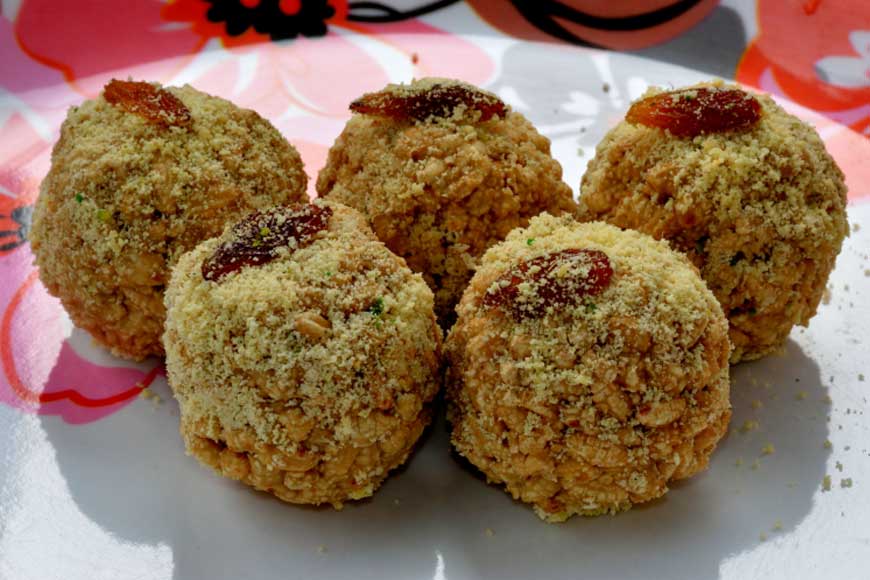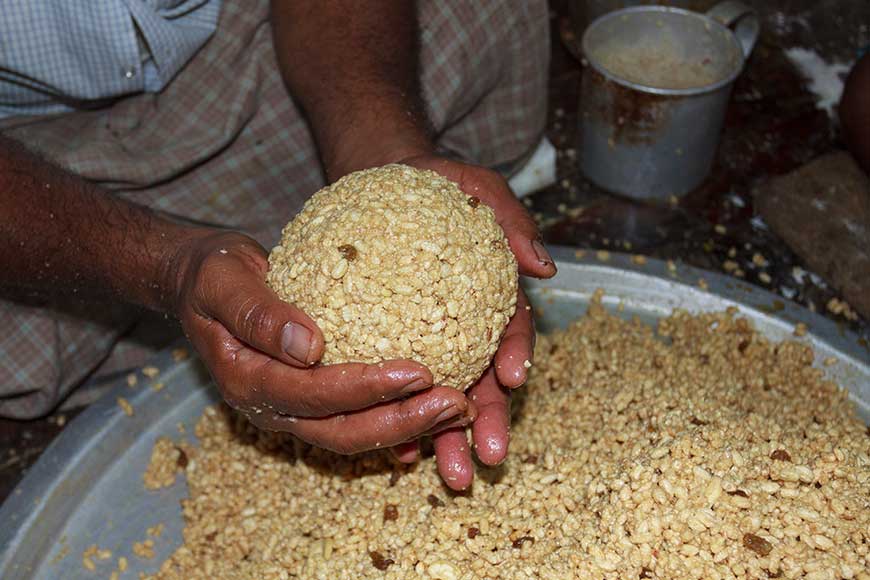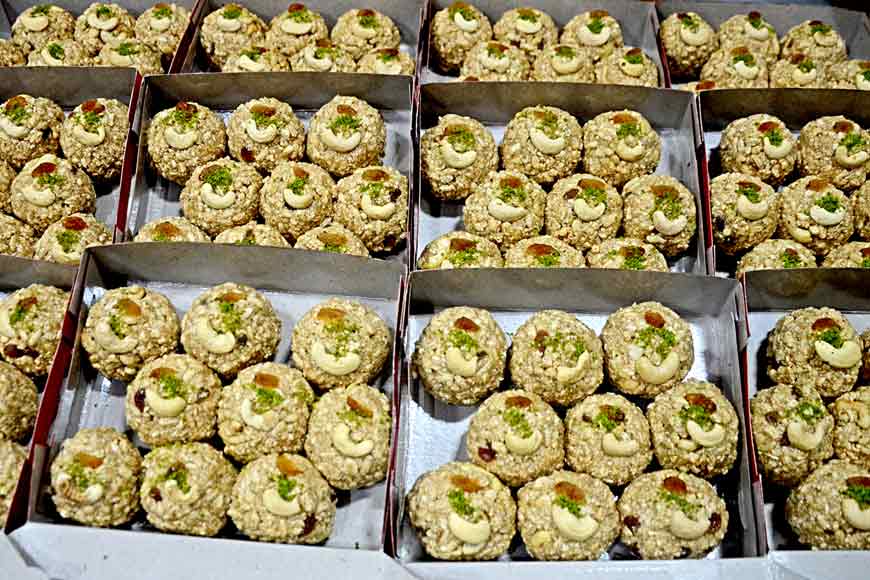Joynagarer Moa, not just a sweet, but a brand in itself

“Let us save what remains: not by vaults and locks which fence them from the public eye and use in consigning them to the waste of time, but by such a multiplication of copies, as shall place them beyond the reach of accident.”
― Thomas Jefferson
As South Bengal gears up to welcome a brief spell of winter, it is time to savour some of the finest delicacies of the state, and ‘Joynagarer Moa’ is definitely one that’s been topping the list for ages. It is interesting to note how the name of a small town, tucked in a corner in South 24 Parganas, has become a world-famous brand name for a sweetmeat product that was invented here years ago! But then brand names are also prone to multiple copies, and that is what has happened to authentic Joynagarer Moa. Today, almost all confectioners and sweet makers try to make a quick buck with the ‘Joynagarer’ moa tag; it is actually Baharu under Joynagar in South 24 Parganas, 47 km away from Kolkata, that has recently acquired the Geographical Indication (GI) tag for producing authentic moa. This was a step to preserve the authenticity of the product.
Joynagar Majilpur, popularly known as Joynagar, is a city and a municipality of the South 24 Parganas district in West Bengal. It is an ancient settlement that derives its name from the local goddess and presiding deity of the area, Ma Joychandi. Over time, it became Joychandinagar and then Joynagar. It is said that the first settler here was Gunananda Motilal, an ancestor of the renowned Motilal family of Baghbazar. He lived in the 17th century. Once, while going on a voyage, he stopped at Baharu to spend the night under a tree. That very night, Goddess Jayachandi appeared in his dream and ordered him to establish her deity there. After the Motilal family settled there, the Sen family and the Mitras’ of Barisha set up homes there and settled down. The deities at the Radhaballav temple set up by the Mitras’ are still worshipped daily.
 Jaynagarer Moa: a seasonal delicacy, South 24 Parganas, West Bengal
Jaynagarer Moa: a seasonal delicacy, South 24 Parganas, West Bengal
Joynagar was an important janapada that grew up along the old Bhagirathi channel from ancient times until around the 16th century. Bipradas Pipilai's ‘Manasavijaya,’ composed in 1495, mentions many places in this region. Chand Sadagar, a merchant character of the ‘Manasavijaya,’ reached Baruipur from Kalighat through the old Bhagirathi channel. Chaitanyadeva (1486–1534) also went through this route as he travelled by boat to Puri.
Joynagar’s name is intrinsically linked to Bengal’s glorious past. When Raja Pratapaditya Roy, the last independent Hindu king of Jessore, was defeated by the Mughal forces, the state Diwan's (Grand vizier) family and the state Priest's family were forced to flee to avoid persecution and conversion. They settled down in Joynagar to form the estate of the Duttas, and the Brahmin priest, Sree Krishna Udgata, came over and settled down in what is today the Bhattacharya Para. All the Bhattacharyas of Joynagar are his scions, with the current 13th generation settled out of the town.
The Dewan of East India Company, Nanda Kumar Basu, was the landlord of Baharu village in Joynagar. He built the Shyamsundar Temple, that is renowned for its architecture and sculpted designs on the walls. There are temples dedicated to Lord Shiva and Dharmaraj. Bengali poet Shakti Chattopadhyay and singer Hemnata Mukhopadhyay both had their ancestral roots here.
The historic town was also a hotbed of revolutionary activities during British rule. Freedom fighter Kanailal Bhattacharya hailed from here, as did Pundit Shibnath Shastri, Dr. Nilratan Sarkar, Jogindranath Sarkar, Janakinath Basu, Dr. Bimalkrishna Motilal, singer Nirmala Misra, and many other illustrious Indians. Today, Joynagar is a brand name; the town is the cradle of'moa,’ a unique seasonal sweetmeat that holds a special seat of honour in the minds of Bengalis from across the globe. Nolen gur and Kanakchurkhoi are mixed with a liberal amount of Khoya kheer (hardened milk), pistachios, cardamom powder, cashews, raisins, and pure ghee to form the rounded'moa' balls that melt in the mouth. It’s pure magic! It is this distinct taste that compels sweet lovers to gravitate towards this delicacy. Bengalis’ love affair with the Joynagarer Moa is an ancient one.
Come winter, and the quintessential Bengali feels a heightened sugar rush in his veins. The sweet fragrance of nolengur (jaggery made from date palm sap) in the air enhances the taste buds. Peddlars reach distant corners of the state and even beyond with their basket-full of winter-special ‘authentic Joynagarer Moa.’ Lanes and by-lanes reverberate with their alluring calls to taste and buy the moa. Local sweet shops, railway stations, and bus terminuses display the ‘Moa’, all claiming to be the ‘original Joynagar product.’ But what is it that makes this sweet so special?

Moa-making is a tedious task. It begins with the sap collection from date palm trees. With the onset of winter, ‘Shiulis’ (sap collectors) make incisions on the trunks of the date trees, attach a short pipe (nol in Bengali) at the point of incision, and point it to an earthen pot hung on the tree trunk. The date-sap trickles down through the pipe into several earthen pots hung on the trunks. The pots are collected at the crack of dawn. The liquid is then boiled (usually in a metal pot) till it thickens and turns into rich golden brown ‘Nolen Gur.’ Once the jaggery is ready, the kanakchurkhoi is mixed.
Kanakchur is an aromatic and special variety of slender rice grain that is cultivated in West Bengal. What makes it special is the fact that the khoi (puffed rice) melts in the mouth, unlike other qualities of khoi. This special quality of Kanakchurkhoi is cultivated organically in a very few pockets in and around Joynagar during the winter. The rarity of Kanakchurkhoi and nolengur produced in Joynagar makes the moa irresistibly special and almost impossible to imitate elsewhere.










